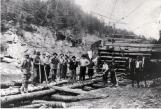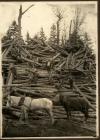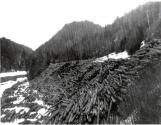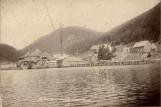1
The Lumbering IndustryFollowing the Napoleonic Wars in Europe from 1803 to 1815, Britain was cut off from its timber supply in the Baltics. Unable to rely on traditional sources of timber, Britain quickly turned to its North American colony as a new supply source. Albert County in particular was well suited to meet this demand, thanks to the geography of the area. Albert County with its large tracts of virgin timber, located on steep hills surrounded by river valleys which empty out into the Bay was an ideal location to harvest timber. By the 1820's a number of rivers had been dammed and water wheels built to power the sawmills. Timber from these mills could be utilized to build wooden ships by local shipbuilding companies or transported by sailing vessels to other markets. Demand for timber grew to the point that the 1851 census for Albert County recorded 97 sawmills operating in the County. Many of these mills were smaller operations with wood being cut within a mile or two of the sawmill.
Spruce and Tamarack were two of the species cut down and sent to the mills but White Pine was especially valuable since it was used to make the masts of wooden ships. All settlers of the area since the arrival of the first English and German settlers had been forbidden in their land deeds to cut white pine on their lands. All of the white pine in the province was reserved for the King and his Royal Navy. The men of the area would farm in the summer then in the winter they would leave their families and go to live and work at lumberjack camps in the woods. Timber would be harvested by chopping down trees using an axe, or two men would work together using a two man cross cut saw to fell the tree.
3
Photo of George & Meredith Bogle using a two man cross cut saw to harvest a spruce tree.19 September 1915
Alma, New Brunswick, Canada

4
Next the logs would be hauled by teams of horses to the banks of the river.6
The logs would then be piled up in large ‘brows' which often covered the entire side of a hill.8
During the spring freshets these logs would be ‘river drove', or floated, down the river to large millponds at the mouth of the river.9
This photo shows a log jam at the mouth of the Point Wolfe River.19 September 1915
Point Wolfe, New Brunswick, Canada

10
This photo shows a log jam at the Point Wolfe Dam.19 September 1915
Point Wolfe, New Brunswick, Canada
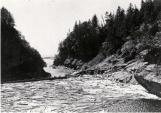
11
An unidentified man using a 'Pike Pole' to push logs in a log boom on the Alma river.19 September 1915
Alma, New Brunswick, Canada
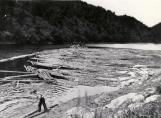
13
In the spring when the water level at the dams up stream had reached a certain level the gates would be hoisted and a wall of water would rush down the river collecting the logs already in the river and hurdling them down stream towards the mill. Men along the river banks would work feverishly to make sure that all the logs piled up in ‘brows' along the river were pushed into the river before the rushing water subsided. This was a very dangerous time, and watch men along the river would yell to the people down river "Dam Water" when the dam waters began to rush. Those who did not hear the cry would soon hear a great roar as a wall of logs and water rushed down stream. Large sawmills at the mouth of the river would then saw the logs into lumber and often load the lumber directly onto sailing schooners docked at the mill.14
A group of workmen standing on the wharf at Point Wolfe.19 September 1915
Point Wolfe, New Brunswick, Canada
